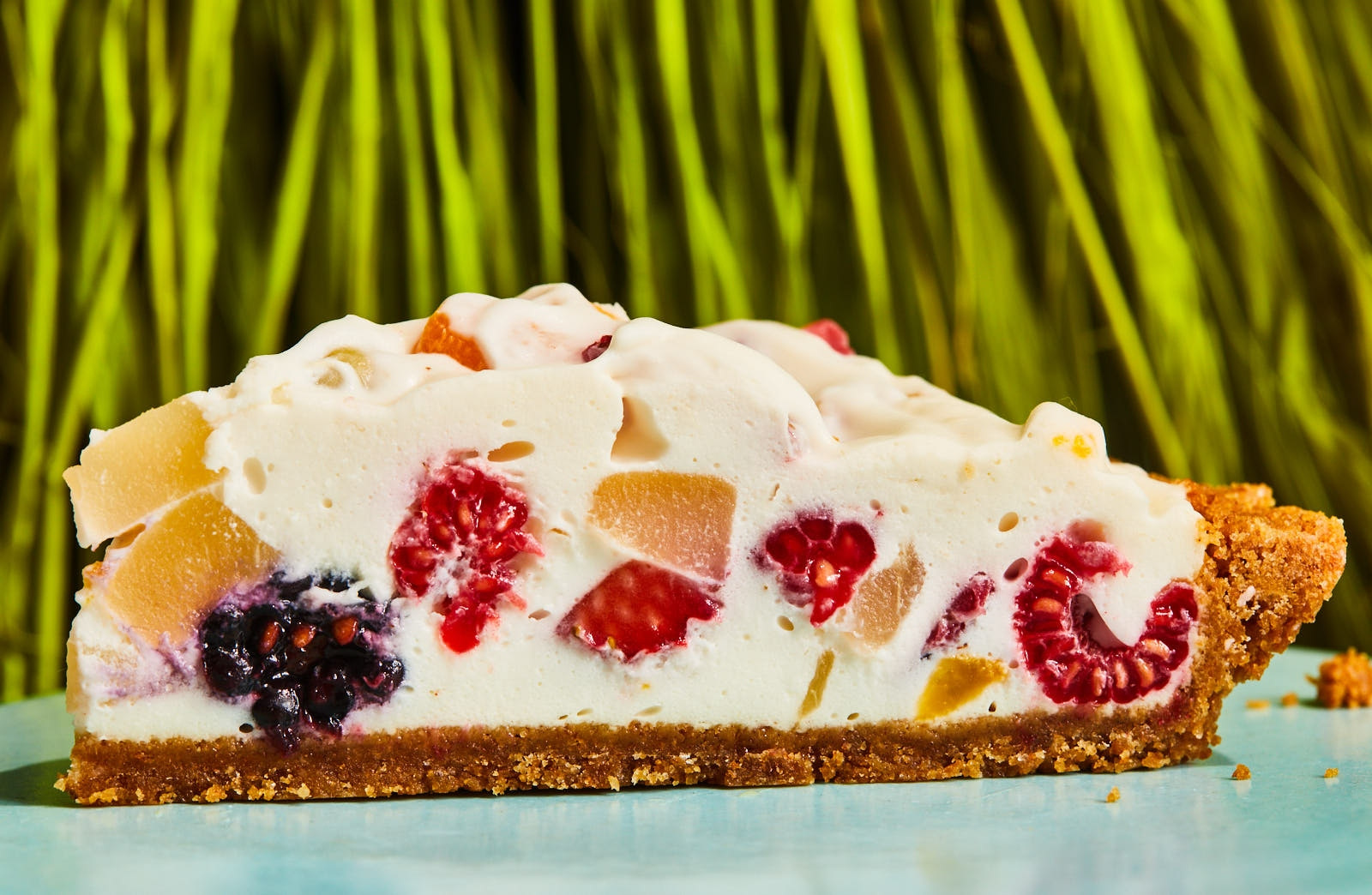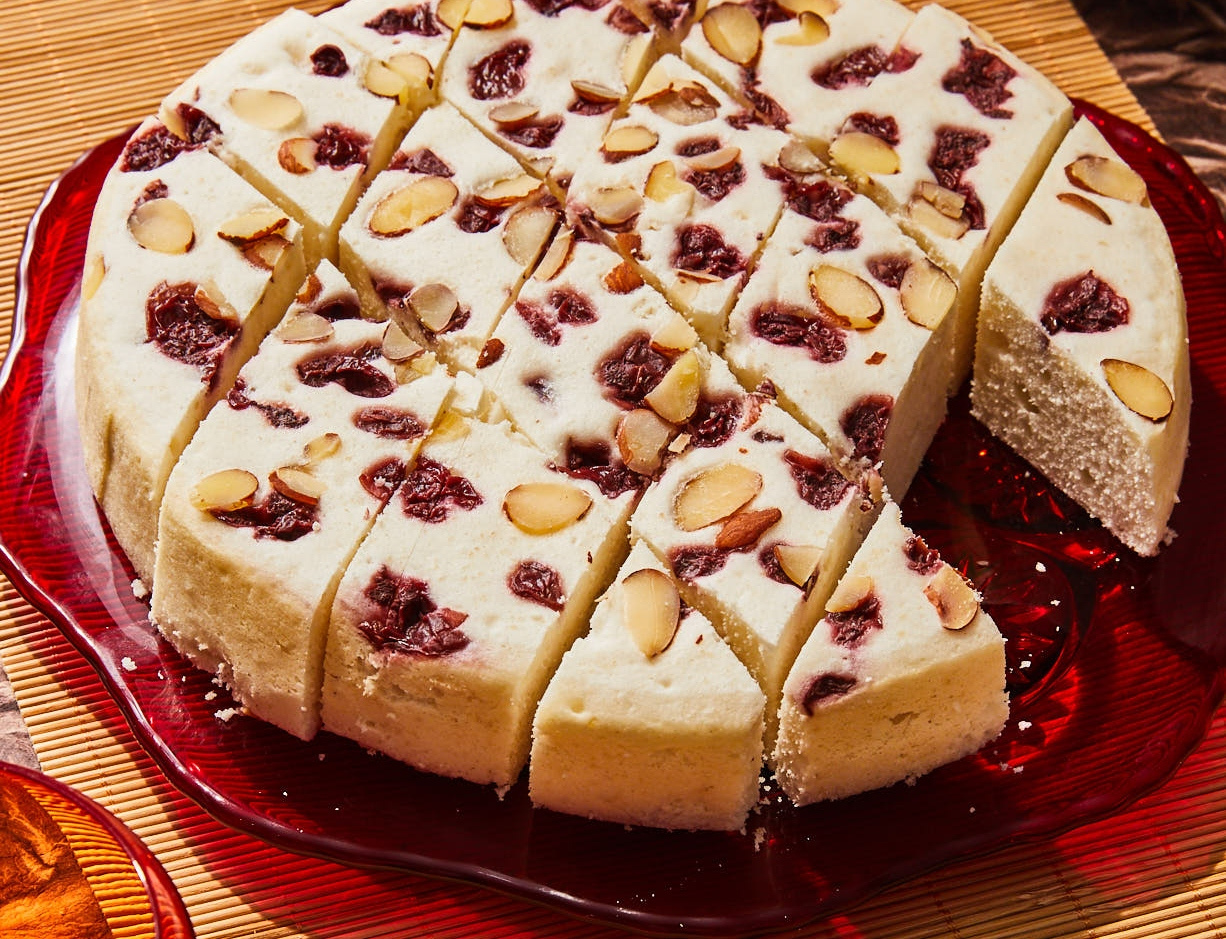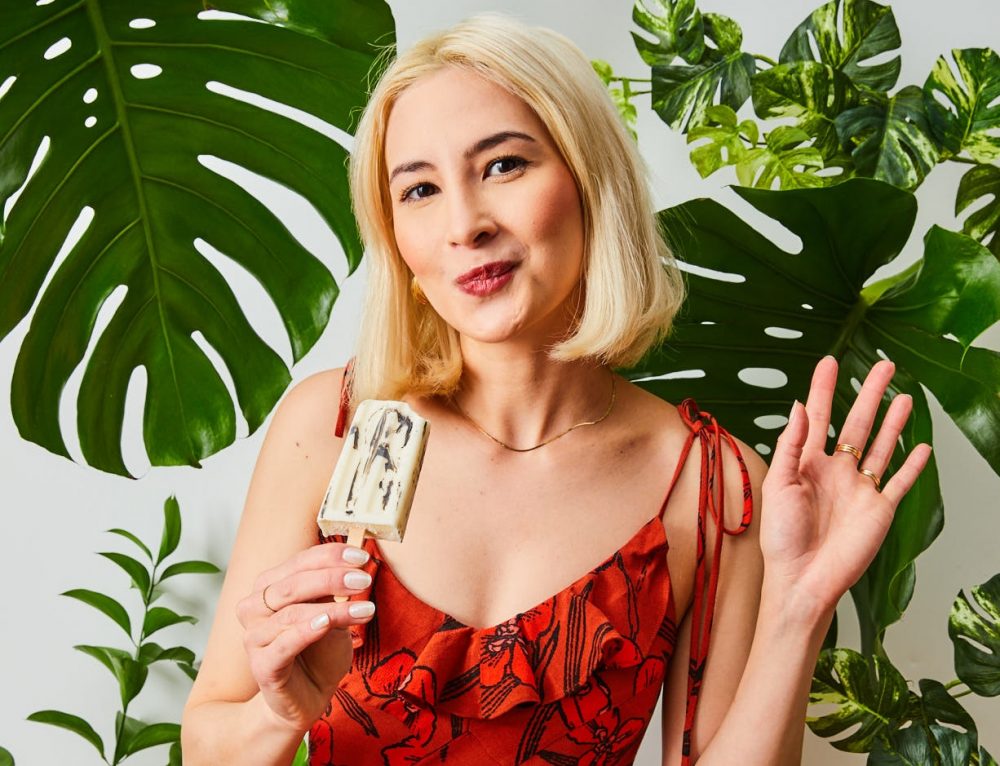It would be easy to feel intimidated by the glossy photographs of towering Ube-Coconut Cake and vividly green Pandan Coconut Cream Pie, but it’s clear from the get-go that Osborne wants you to succeed. The book is all killer, no filler, and visually stunning—aspirationally so—but it’s also warm, inviting, and deeply personal, with recipes that read like excerpts from a memoir. Sugarcane is instructive, intimate, and educational all at once, with essays about the history of the Philippines and the effects of colonialism interspersed between cakes and cookies, giving the reader a deeper appreciation for the region and its cuisine.
Osborne will be teaching a class on Filipino desserts on April 2, but in the meantime, she was nice enough to hop on a call and discuss making mochi in the microwave, the differences between American and Filipino desserts, and why she can’t wait for pandan to finally have its moment.
What are some of the big differences between American desserts and Filipino desserts?
With Asian desserts in general, the goal—the best compliment you can give—is “not too sweet.” We like desserts that aren't cloyingly sugary. And American desserts are very sweet. They're known to be very sweet, especially in different regions like the American South, which is where I grew up.
Two: Obviously, the produce and the ingredients are going to be very different. In America, it’s your cakes, your pies, cherry pie, apple pie—that sort of thing. Filipino desserts rely on the ingredients they have geographically. So a lot of tropical fruits, mango, a lot of rice in various forms, a lot of coconut in every form as well.
And then I would say texture is a very big one. Chewy is the “it” texture in Filipino desserts—just that bouncy, kind of chewy texture. There's actually a term for chewy rice cakes in Filipino desserts. They're called kakanin, which is just [the word for] rice cakes. There's a lot—they’re all chewy.
I think in the traditional sense, that's the answer. But I do think American cuisine in general is something that's changing.
Can you tell me a little bit about turning Filipino fruit salad into a pie?

Fruit salad is a classic Filipino dessert. It's something that we have no matter if it's a holiday or just a weekend get-together. And I knew I needed to have it in the book, but I wanted to do something different, not just your classic fruit salad, and I really wanted to incorporate all of the same ingredients, which is very simple. It's just a few ingredients. Then I had the idea of trying to turn it into some type of creamy fruit pie. I thought it would be a really great one to kind of merge together and incorporate some fresh fruit, because Filipino fruit salad is traditionally [made with] a canned cocktail.
The only problem is I really wanted to use tropical fruits. But tropical fruits have an enzyme in them and gelatin does not behave the way it should because the enzyme breaks down the gelatin. I think it's the bromelain in pineapple and there are other ones in mango. I learned that just by experimenting. I was like, “Why isn't this setting up? I'm putting so much gelatin in it.” So it's essentially the fruit salad—all of the same ingredients, with the exception of adding gelatin. I added a little bit more gelatin, because usually a fruit salad has Cool Whip in it, and that does have some gelatin.
Can you tell me a little bit about your decision to include MSG in your Chili Crisp Chocolate Chunk Cookies?
Definitely. So, there's this huge conspiracy—or I guess there was before—that MSG is so horrible for you, but it's just not true. When I was growing up there was MSG in the spice cabinet. That was just something that we would use in our cooking. And a lot of ingredients that you can find at the Asian supermarket will have MSG built into them. I knew I wanted to have it somewhere in the book, I just wasn't sure where it was going to go yet. Kind of the same thing with the SPAM. I knew I wanted to have SPAM in something but I wasn't sure where it was going to go yet.
“When I was growing up there was MSG in the spice cabinet.”
But I just was thinking of pantry staples, what would be a place that flavor would go really well? I think MSG would go well in any dessert, but I settled on the chili crisp, because I feel that has become an Asian-American staple, just across every Asian culture. It’s so good. And it has MSG built into it. And I just knew it was going to taste delicious with a brown butter chocolate cookie situation. And I think it's a great recipe to get people familiarized with that ingredient.
Another flavor pairing that you feature in the book is corn and coconut, which made its way into a custard cake. What are some of your other favorites that pair those flavors?
So corn and coconut—maja blanca is the one that I'm most familiar with. But a lot of places in Southeast Asia use that same combination as well, like Singapore and Malaysia. They've got their own corn and coconut dish. And there's even a corn on the cob with some sort of coconut glaze on top. And then sometimes I'll see little snacks at the Asian grocery store, and it'll be corn and coconut. And it really is just a nice combination. For anyone who's never tried it before, I'm super excited for them. Because it's a sleeper; you just don't know how good it is until you put them together.
Another one is mais con yelo popsicles. That one doesn't have a photo in my cookbook, but it's kind of like the corn and coconut version of Filipino halo halo, which is a crushed ice sundae. I actually like it better than halo halo because I love corn and coconut as a flavor combination—corn has that very buttery [flavor], and it's lightly savory but sweet. It's got it all.
Are there any other Asian or Filipino dessert ingredients that you wish more people knew about?
I am hoping that pandan is going to have its moment in the sun. I feel like ube went from trendy to very mainstream. And that took a little while but everyone's familiar with it and everybody loves it. And obviously, you just need to give it a chance. Its counterpart is green, and I also think it's a wonderful flavor. I really want people to start cooking with that because it's just as good as ube.
“I am hoping that pandan is going to have its moment in the sun.”
It's like this shrub. And you can find it in most Asian grocery stores in the freezer section, but I describe it as a grassy vanilla. But it's not grassy like matcha. It's kind of hard to describe, but it's nutty and fragrant. It's really special and it's kind of known as “the vanilla of the East.”
Another thing you do is combine sesame oil and chocolate in a cake. Was that a pairing you always had in mind?
I have always wanted to experiment with it. I like oil-based cakes, but I wanted to try a sesame oil-based cake for a while now, but I just had it in my back pocket for when I was going to write this cookbook. And when I got down to thinking about what it was going to be, I felt chocolate was going to go really well with that strong sesame flavor, and you don't want to put something delicate like lavender with sesame oil. I like to taste the flavors in my dessert. So when I say it's going to have sesame oil in it, you're going to know, you're going to taste it. So that chocolate, that bitterness—that really does kind of help round all those flavors out.
“I get the allure of a black bean brownie, I guess? Actually, not really. I'm not into it.”
And it's moist! I mean, it's not for everybody, because some people are like “It's too strong.” But then I have people that just go crazy for it, and they're like, “Yum! This is amazing.”
Speaking of chocolate, you have a red bean brownie, which is so smart, and very different from the black bean brownies we have here in the U.S.
I get the allure of a black bean brownie, I guess? Actually, not really. I'm not into it. I think if you want a brownie, have a brownie and have black beans elsewhere in your day. But beans in dessert is so ubiquitous in Asian cuisine, and Filipinos love to put beans in so many things. The brownie is a great place to [feature it] because it's intentional. It's sweetened. And I'm not trying to use the chocolate to hide the red bean flavor or make it healthy or anything like that. You can really taste it. There's just a little bit of cocoa powder to kind of accentuate that flavor.
And red beans are more dessert-y in nature than black beans.
Yeah. It's not as starchy. So it's a little more moist. You can kind of spread it around a little bit more easily than if you mashed up some black beans. Black beans are kind of dry.
How popular are steamed desserts in the Philippines, and how common is oven-cooking?
I would say ovens are pretty popular. Although, I think for a long time my family didn't have one; we were just cooking in a makeshift oven over a fire, which is hard, but I guess it's why my mom doesn't have timings for anything. And no heat [specifications] because it's like “There is no 350℉!” or whatever. They have ovens now, of course, but they love fire cooking.
Boiling is a big one. Steaming is a big one, but not as much as it is for other Asian desserts like Japanese or Chinese with dim sum and that sort of thing. Actually, puto is the only dessert that I'm familiar with in Filipino cuisine that requires steaming.
Can you describe the texture of a steamed dessert versus a baked one?
A baked one is going to be just your classic cake. And it's going to have that nice moist crumb. When you put your fork into it, it kind of squishes down—you know, it's moist. Steamed desserts—it’s not that it's dry, but you're not necessarily going to use the term “moist” to describe a steamed cake because the crumb is totally different. The way it cooks, it's completely surrounded in this spa, essentially. It's in its own personal spa. And the crumb is very bouncy—not quite chewy because there's regular flour in this one. But it's a different experience for sure.
And puto is typically made small, almost cupcake-sized. What made you decide to expand it into a whole cake?

So, puto is not actually a dessert kakanin. It's supposed to be just a very basic little cake. It's plain, unless you want to
add cheese on top—that’s another typical addition. But it's just rice flour and some milk, and it's supposed to taste like rice—very plain. And you would dip it into stews or soup or have it alongside pancit or whatever it is that you're serving.
When I was making this, I wanted it to be a big puto cake. I wanted it to be sweet. Because when I was younger, I was always like, “This isn't sweet” And my mom was like, “It's not supposed to be sweet.” So that's why I wanted to make it a little bit bigger, make it actually a dessert. And it's a really nice one.
Another recipe that stuck out to me was the Yakult leches cake. Can you tell me a little bit about your history with that ingredient and what inspired you to use it in a cake?
I love that one, too. Yakult is a probiotic Japanese drink. I think there's also a Korean version. And a part of Asian American childhood was having these little Yakult drinks. They kind of have this very lactic, sour taste. And they come in this toy-sized little bottle, and me and my sister would even put them in the freezer, so that we would have a Yakult popsicle after school.
“If I'm going to say it's in there, you're going to taste it!”
And I knew it had to be in a dessert, but I didn't want to cook off the flavor. I didn't want to just add it into a cake and then lose some of that potency. I thought a Yakult leches cake would be perfect because you could add some of the Yakult into the cake that bakes, but then have a lot of the soaking liquid be Yakult, so you could really get the flavor of it. Because again, if I'm going to say it's in there, you're going to taste it! That one's a great dessert too, and I think it's very nostalgic for anyone who had Yakult a lot as a kid.
Going back to that bouncy texture: Can you describe what mochi does in your chocolate chip cookies?
I think mochi is another one of those dishes and flavors that has become more mainstream in American-Western cuisine. And it's very chewy. It's very stretchy. I knew I needed it in the book. I am not really a big cakey cookie person. It's just not for me. I don't like a cakey cookie. I like a chewy cookie. And I just knew that mochi was going to create the chewiest cookie there ever was. And it is.
And I wanted it to be easy. So you're making the mochi in just a regular microwave. You don't have to do anything special. And they're best when they're warm, because it's so stretchy and you get that chew. And again, in Asian cuisine, we just love chewy. There's actually a term for chewy—it’s Taiwanese, but it's called QQ. And we love it.
I didn’t even know you could make mochi in the microwave
Oh my god, it's so much easier. I've done it on the stove—plenty—but it's way easier in the microwave.
This interview has been lightly edited for clarity.
Photography by Linda Xiao, food styling by Molly Wenk, prop styling by Ashleigh Sarbone & Maeve Sheridan.
Join the conversation on Facebook, Instagram, TikTok and Pinterest.
And if you're looking for more Milk Street, check out our livestream cooking classes with our favorite chefs, home cooks and friends for global recipes, cooking methods and more.







